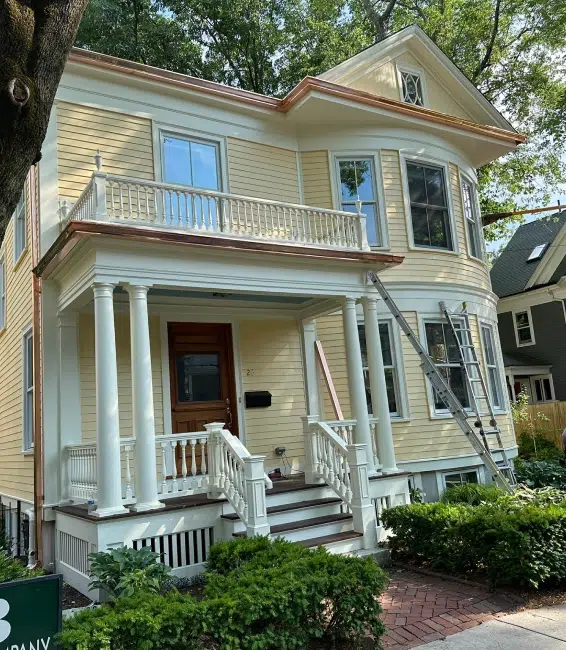
Homeowners often don’t consider the adverse impact a winter storm could have on their roofing system. Most homeowners are aware that warm weather hailstorms, windstorms, and thunderstorms can wreak havoc on a roof by causing extensive and intrusive storm damage. However, winter weather may have a similarly devastating effect on a home’s roof, especially for the unsuspecting homeowner not anticipating this “off-season” challenge.
Winter Is Prime Season For Storm Damage

Snow, sleet, ice, wind, and freezing temperatures can generate catastrophic and untimely roofing problems. Unfortunately, many homeowners never realize that roof damage is just as likely to occur during cold weather months as in warmer seasons.
Additionally, homeowners often delay roof repairs until springtime if storm damage occurs during winter. They wrongly assume that qualified roofing contractors “retire” for the season or can’t work on a roof in cold, snowy, or icy weather conditions.
A savvy homeowner must prepare their roofing system for wintry weather in autumn (or even summer). Utilizing proactive measures to reduce the likelihood of winter storm damage to their roof protects the homeowner from costly and untimely repairs.
Types Of Roofing Damage Observed During Cold Weather
Winter months in the Northeast often lead to roofing problems, including the following commonly observed issues:
Cracked Shingles
Weather extremes (including frigid temperatures, harsh winds, icy conditions, and heavy snowfalls) unduly stress asphalt shingles. Consequently, they become more brittle and increasingly susceptible to cracking. Even the smallest cracks can cause significant challenges. Damaged shingles are the leading cause of roof leaks.
Flashing Leaks
Flashing is typically manufactured from corrosion-resistant aluminum, metal, or steel. Roofers install flashing adjacent to vulnerable areas (such as valleys, eaves, and penetrations) to eliminate roof leaks. Unfortunately, flashing is susceptible to deterioration during the freeze-thaw process and persistent exposure to winter weather.
Ice Damming
Heat escaping the attic space through the roof causes accumulated snow to melt and flow downward to the roof’s edge (i.e., eave). If temperatures are subfreezing, the snowmelt will refreeze into ice at the eave. The result is an ice dam. Subsequent snowmelt and snow accumulation will become backed up behind the ice dam.
Moisture Intrusion
Freezing temperatures may cause micro-fissures at critical junctions in a roofing system. For example, tiny cracks in roof sealants around skylights and vents allow moisture to penetrate the roofing surface to the sublayers. If not proactively addressed, these small openings can create significant water damage problems.
Structural Damage
Accumulating snow (or ice) weighs heavily on the roof. This excess buildup may compromise the structural integrity of the underlying roof layers, including the decking, trusses, and rafters. Homeowners must manage the amount of snow packed on the roof and take measures to remove the surplus to avoid the roof sagging or collapsing.
Preventing Storm Damage In Winter
Reduce the possibility of a winter storm creating problematic conditions for your roof by employing preventive measures.
Clean Gutters & Downspouts From Excess Debris Buildup
Clogged gutter channels prevent snowmelt from flowing through them. They also may exasperate issues with ice damming. Before winter arrives, a homeowner should involve a professional gutter cleaning service to remove leaves and branches. Alternatively, the homeowner could have gutter guards or shields installed.
Installation Measures To Reduce The Risk Of Ice Dam Formation
A homeowner has many options to diminish the possibility of ice damming. One core objective is to reduce excess heat buildup under the roof’s surface. Adding new insulation or improving attic ventilation ensures reasonable airflow, moderating temperatures adjacent to the roof. Installing heated ice melt panels along the roof’s edge can also help.
Remove Excess Snow & Ice Accumulation As Soon As Possible
Too much snow and ice weigh heavily on the roof and will damage it. Homeowners have many options to extract excess snow and ice. A roof rake, shovel, or leaf blower can help clear the roof of snow and ice. However, the risk of a slip-and-fall accident increases dramatically during winter. Instead, involve a trained roofing professional.

Replace Faulty Or Damaged Flashings Or Cracked Roof Sealants
Roof leaks happen when flashings or sealants adjacent to roof protrusions or junctures fail to perform as expected. Minor repairs can help the homeowner avoid extensive problems, which may yield thousands of dollars in damage. A roof inspector will identify issues and recommend repairs or replacements of flashing or sealants.
Secure A Roof Inspection Near The End Of The Fall Season
You don’t know what you don’t know. Obtaining a roof inspection from a trained and certified roof inspector provides you with crucial information to understand your existing roof’s condition. Are there shingles requiring replacement? Do roofing components need repair? Is there a potential issue demanding closer examination? You’ll find out.
Involving A Knowledgeable Roofing Professional
Greater Boston homeowners face substantial risks of storm damage to their homes during winter months. Harsh weather conditions will lead to unexpected roofing challenges for the unprepared homeowner. If you need guidance to minimize or eliminate the possibility of storm damage during the cold weather season, contact O’Lyn Roofing today. We have the expertise to help you reduce or offset the impact of an unforgiving winter storm.










